Also a medal designated the 1914 Star but popularly known as the Mons Star was awarded to those who had seen action in a theatre of war in 1914; and a similar 1915 Star to those who saw action in 1915. A serviceman could not receive both. These stars are useful in confirming that the recipient had been a volunteer, since conscription was not introduced until 1916, after which no further stars of this type were issued. The reverse is not true, of course. The lack of a Star could indeed mean that the person was conscripted, but it could also mean that he joined in 1914 or 1915 but had not seen action or had not seen it until 1916 or beyond.
There was a further award, the Silver War Badge (SWB). This was strictly not a medal, but a badge which was given to servicemen who had been released from active service under para 392 (xvi) of King's Regulations because of wounds or sickness. Some were released from the service but most seem to have returned to non-combattant duties at home, for example in the Labour Corps. Wearing the badge would be an indication of this status in the context of a situation where young men not at the front line were often called cowards.
At the time that this was prepared (2015) more information on these medals, and in particular notes on those who were entitled to receive them, could be found on the Imperial War Museum web site, as follows: http:// www.iwm.org.uk/history/british-first-world-war-service-medals
This information is taken from the index cards at the National Archives (ref WO/372) and we are grateful for their help and assistance. Also acknowledgement goes to the Imperial War Museum (web site above).
The British War Medal
The British War Medal was approved by King George
V in 1919 to commemorate the services rendered
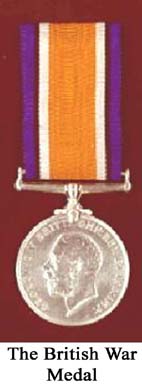 by His Majesty's Forces and to record the bringing of
the war to a successful conclusion. Eligibility for the award was later
extended to cover the years 1919?1920, while post?war mine clearance at sea
continued, as did service in North and South Russia, the Eastern Baltic,
Siberia, Black Sea and Caspian Sea.
by His Majesty's Forces and to record the bringing of
the war to a successful conclusion. Eligibility for the award was later
extended to cover the years 1919?1920, while post?war mine clearance at sea
continued, as did service in North and South Russia, the Eastern Baltic,
Siberia, Black Sea and Caspian Sea.
The medal, which is silver, hangs from
its ribbon by a straight suspender bar without swivel. The obverse bears the coinage effigy of His Majesty the King with the
legend GEORGIVS V:BRITT: OMN:REX ET IND:IMP:. The reverse depicts a male figure
mounted on horseback, trampling underfoot the eagle shield of the Central
Powers and the emblems of death, a skull and cross?bones. Above is the risen
sun of victory, and the dates 1914 1918. The male figure was chosen because men
had borne the brunt of the fighting.
swivel. The obverse bears the coinage effigy of His Majesty the King with the
legend GEORGIVS V:BRITT: OMN:REX ET IND:IMP:. The reverse depicts a male figure
mounted on horseback, trampling underfoot the eagle shield of the Central
Powers and the emblems of death, a skull and cross?bones. Above is the risen
sun of victory, and the dates 1914 1918. The male figure was chosen because men
had borne the brunt of the fighting.
The British War Medal The design
symbolised the mechanical and scientific advances which helped to win the war.
The silk ribbon has a central vertical stripe of gold with stripes of white and
black at each side and borders of royal blue. It is not thought that the
colours have any particular significance. The recipient's name, rank, service
number and unit are stamped on the bottom edge of the medal. Those awarded to
Army officers, with the exception of the Royal Artillery, omit the name of the
regiment or corps.
The medal was designed was W McMillan, and struck by the
Royal Mint. The total number of medals awarded is as follows: silver: 6,500,000
bronze 110,000
The Victory Medal
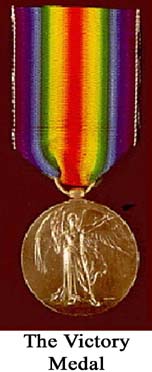 The Victory Medal
was authorised in 1919 to commemorate the victory of the Allies over the
Central Powers. It is lacquered bronze and bears on the obverse the classical
figure of Athene Nike, the goddess of Victory. On the reverse is an
inscription,
The Victory Medal
was authorised in 1919 to commemorate the victory of the Allies over the
Central Powers. It is lacquered bronze and bears on the obverse the classical
figure of Athene Nike, the goddess of Victory. On the reverse is an
inscription,
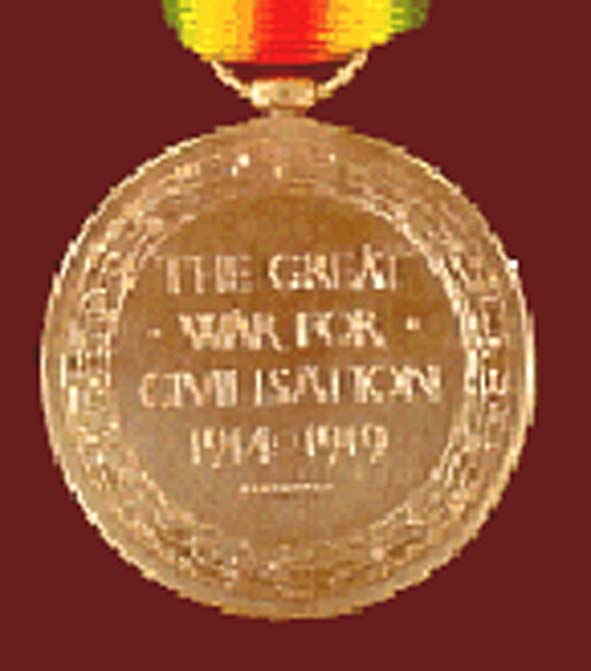 THE GREAT WAR FOR CIVILISATION and the dates 1914 1918.
The version of the Victory Medal issued to members of the South African forces
is identical, except that the obverse inscription is in both English and
Afrikaans.
THE GREAT WAR FOR CIVILISATION and the dates 1914 1918.
The version of the Victory Medal issued to members of the South African forces
is identical, except that the obverse inscription is in both English and
Afrikaans.
The silk ribbon is red in the centre, with green and violet on
either side shaded to form the colours of two rainbows. The medal is suspended
from a plain ring.
Those who received a Mention in Despatches were
authorised to wear, sewn on to the ribbon, a single emblem of oak leaves in
bronze. When the ribbon alone was worn, a smaller version of the emblem was
fixed to it.
The medal, designed by W McMillan, was authorised to obviate
the exchange of Allied Commemorative War Medals. It was struck by the Royal
Mint. The total number of medals awarded is 5,725,000
The 1914 Star
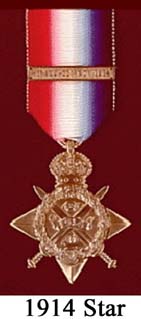 The first "general
issue" medal had been the 1914 Star, often referred to as The 'Mons Star'. In
1917 King George V approved the grant of this medal to all those officers
The first "general
issue" medal had been the 1914 Star, often referred to as The 'Mons Star'. In
1917 King George V approved the grant of this medal to all those officers and men of the British and Indian Expeditionary Forces
who actually served in France or Belgium on the establishment of a unit between
5th August and midnight 22/23rd August 1914. Later, a clasp was awarded to
those who served under fire of the enemy in France or Belgium during the
period.
and men of the British and Indian Expeditionary Forces
who actually served in France or Belgium on the establishment of a unit between
5th August and midnight 22/23rd August 1914. Later, a clasp was awarded to
those who served under fire of the enemy in France or Belgium during the
period.
The decoration is a four-pointed star in bright bronze. The reverse
is plain, but is stamped with the name and unit of the recipient. The ribbon is
red, white and blue silk, shaded and watered, worn with the red nearest the
centre of the chest.
The medal was struck by the Royal Mint, and the
numbers issued were: 1914 Stars: 365,622 1914 Star clasps:
145,000
The 1914/1915 Star
The 1914/15 star, sanctioned by the King in 1918,
is similar in design to the
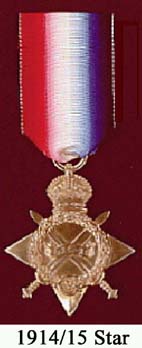
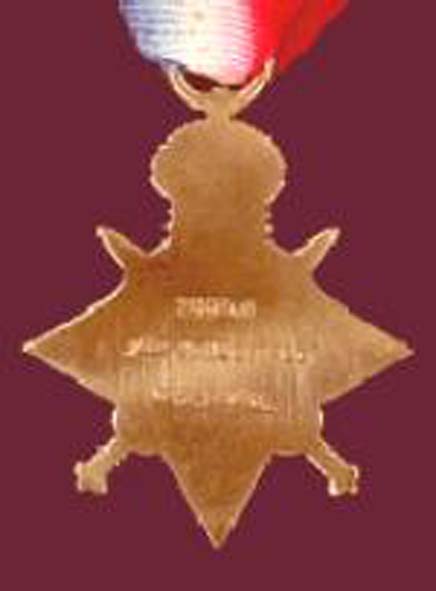 1914
Star but with the dates 1914 -15 on the central scroll and with the smaller
scrolls bearing the words Aug and Nov omitted. . The ribbon is identical to
that of the 1914 Star.
1914
Star but with the dates 1914 -15 on the central scroll and with the smaller
scrolls bearing the words Aug and Nov omitted. . The ribbon is identical to
that of the 1914 Star.
The medal was awarded to those who saw service in
any theatre of war against the central powers between 5th August 1914 and 31st
December 1915, but those having the 1914 star were not eligible.
The medal
was struck by the Royal Mint, and the numbers issued were
2,078,183